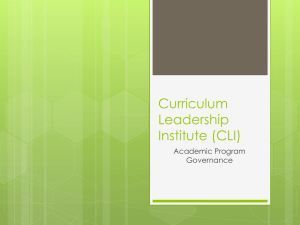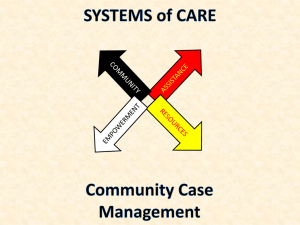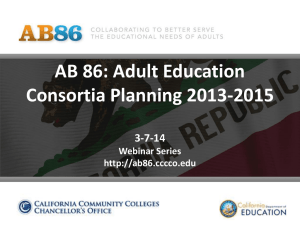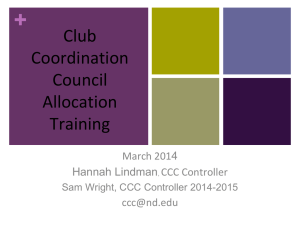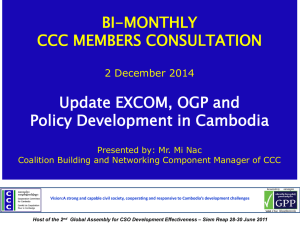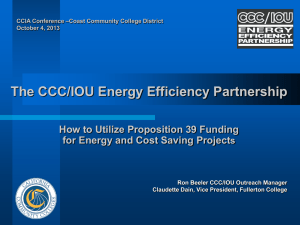CCD Porp 39 - Chancellors Office
advertisement
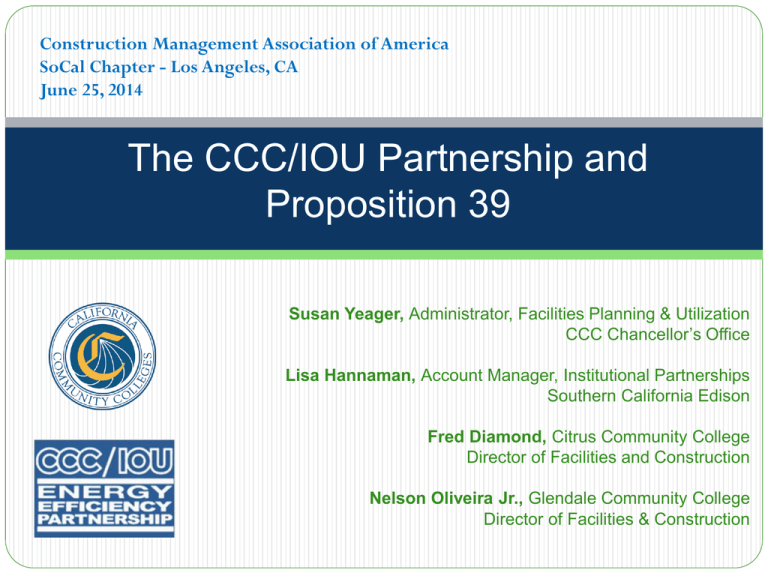
Construction Management Association of America SoCal Chapter - Los Angeles, CA June 25, 2014 The CCC/IOU Partnership and Proposition 39 Susan Yeager, Administrator, Facilities Planning & Utilization CCC Chancellor’s Office Lisa Hannaman, Account Manager, Institutional Partnerships Southern California Edison Fred Diamond, Citrus Community College Director of Facilities and Construction Nelson Oliveira Jr., Glendale Community College Director of Facilities & Construction California Community Colleges Systemwide Detail 72 districts encompassing 112 colleges, 72 approved off-campus centers and 23 separately reported district offices Includes 24,279 acres of land, 5,281 buildings, and 75.6 million square feet of space 2.4 million students annually 75% of the state’s public undergraduate students 25% of community college students nationwide 2 CCC Systemwide Facilities Needs 10-year Facilities Needs = $35 billion Enrollment Growth Needs = 13.3 million new ASF Modernization Needs = 30.5 million existing ASF 67% of buildings: over 25 years old 46% of buildings: over 40 years old 3 Bonds for CCC Facilities State Bonds since 2000 2002, 2004, and 2006 Bond Acts Total available $3.34 Billion 55% of Higher Education bonds Local GO Bonds since 2000 65 of 72 Districts Total approved $26.2 Billion Leverages state-funded projects Funds 100% non-state supportable projects 4 2014 Education Bond Bill AB 2235 Education facilities: Kindergarten-University Public Education Facilities Bond Act of 2014 K-12 $2.25 New Construction $3.25 Mod $500 million Charters Higher Ed $2 billion CCC $500 million UC $500 million CSU Status: Passed Senate High Education committee with amendment. To Governance and Finance Committee June 25th, 2014. 5 Proposition 39 Adopted by the voters in November 2012 to close corporate tax loopholes and will provide roughly $550 million annually to K-12 and CCC’s for Energy Projects for five years CCC’s will allocate $31.6 million for FY 2014-2015 distributed on an FTES basis to all CCC Districts for energy efficiency and renewable generation projects Funding approved annually by legislature with state budget 6 Proposition 39: Implementation CCC Chancellors Office works with Districts and CCC/IOU Partnership to identify and fund projects Implementation parallels CCC/IOU Partnership process to combine Prop 39 funds and leverage utility incentives. IOUs provide technical assistance to identify and develop projects Chancellor’s Office works with POUs to coordinate processes, services, and any incentives A Program Consultant contracted through CCCCO to provide program administration and technical assistance 7 The Process CCC Program Guidelines Reflects requirements of Prop 39 enabling legislation SB 73 Issued by Chancellors Office and defines process and requirements Project qualification criteria Funding application process and approvals M&V and Reporting Requirements Monthly approvals and fund disbursement through state apportionment process Guidelines are for CCC’s only. CEC has issued separate Guidelines for K-12 Proposition 39 Guidelines 3 Primary Phases The Guidelines provide “step-by step” instructions for Proposition 39 Implementation • Apply for Project Funding 1 2 3 • Project Implementation • Verification and Reporting Prop 39 Year 1 Survey Results Year 1: 2013-14 Prop 39 Success $39.67M of $39.8M in Funding Allocated o $128,635 will be reapporpriated to 2014-15 $5.3 of $6M for workforce development All 72 Districts participating $6.8 Million in Utility Incentives 313 Projects: 29% will complete by June 30, 2014. Resulting in ANNUAL energy cost savings of $4.6 million to Districts! 11 Year 1 Project Types Project Type Count % of Total Projects Lighting 171 54.63% HVAC 59 18.85% Controls 48 15.34% Other 15 4.79% RCx 14 4.47% Technical Assistance 3 0.96% Self- Generation 2 0.64% MBCx 1 0.32% Total Projects 313 12 Impact of Proposition 39 13 Year 2 Budget and Pipeline FY 14-15 Proposed Budget – $31.6M 20% less funding Year 2 Projects: Over 200 already submitted 25+ Solar Projects 68/72 Districts have projects identified $42M est. Construction Costs Focus on more comprehensive projects with higher energy savings 14 Key Issues Contracting Requirements: Projects funded by awards shall require contracts that identify the project specifications, costs, and projected energy savings. “a community college shall not use a sole source process to award funds pursuant to this chapter” Districts may use Government Code 4217 District Annual Expenditure Report: Not sooner than one year but no later than 15 months after completion of its first eligible project, District shall submit an Annual Expenditure Report Job Tracking Form: Direct FTE & Trainees created from Prop 39 implementation State Compliance: District Prop 39 expenditures will be subject to an annual state compliance test as outlined in the Contract District Audit Manual 15 Prop 39 and the CCC/IOU Partnership CCC Guidelines Leverage Partnership Processes, Services, and Incentives Districts should work with IOUs to identify projects, prepare energy calculations, and submit both incentive and Prop 39 funding Project M&V and Reporting will be facilitated by utility process Your Success is our Success! We both want Energy Savings 16 Program Incentives for 2013-14 INCENTIVE RATE MEASURE Electricity Packaged HVAC, HVAC Controls, Motors, Drives Lighting, Lighting Controls, Daylighting Central Plants, Chiller Retrofits, and other major Energy Efficiency Infrastructure Projects $0.24 / kWh Monitor Based Commissioning (MBCx) IT Projects Natural Gas $1.00 / therm ALL Gas Measures 17 Prop 39 Challenges Opportunities & Team Strategies Fred Diamond Director of Facilities & Construction Citrus College Opportunities for Success CM Opportunities… The first rule of success… Know your business Know your client Know the program Know where to go 19 Overcoming Challenges Project lead times may impact delivery Material supplies (supply vs. demand) Public Contract Code requirements In-house labor limitations Consultant and vendor limitations Think ahead for success 20 Strategizing… Communication is critical Facilities / vendors—establish relationships Plan your strategy prior to procurement Know your project thoroughly Limit substitution times per PCC §3400 Collaborate…Notice of Intent to Award ONE person should be in charge Success awaits!! 21 Utilize your Assets California Community Colleges—Energy Project Guidance pamphlet CCC-IOU Partnership Management Team Chancellor’s Office Utility Account Executives Industry Professionals Fellow Colleagues Don’t hesitate to ask questions! 22 ENERGY CONSERVATION & MODERNIZATION FOR GLENDALE COMMUNITY COLLEGE June 25, 2014 Nelson Oliveira, Jr., CHFM, CHSP, LLB, MBA Glendale Community College • Founded in 1927 • Campus established in 1936 • 15 permanent buildings sit upon 100+ acres • 900,000+ Square Feet of conditioned space • • Lab College Services Building, currently in construction; threefloor, 90,000 sq ft 25,000 Day and Evening student population Facility Modernization Needs - Background Needs of the Campus • Obtain a better window into where our money is being spent on facilities • Current Maintenance Practices • Primarily needs based • Reactionary • Fix when broken • Minor work order management • Reduce operational expenditures and control increasing energy costs Road Map to a Successful Program Facility Condition Assessment RCx Investment Grade Audit Systematic Approach to Optimal Facility Performance • Understand where operational dollars are actually being spent and the current mission of the facility • Reduce unnecessary investments being made in a building that is inherently inefficient • Optimize facility efficiency (=operational cost savings) • Make efforts to improve the energy baseline before capital investments are made • Incorporate no-cost, low-cost measures first • Assess required capital improvements to optimize current facility objectives • Customize long-term planning based on actual facility conditions • Install supply-side measures based on optimized facility energy demand Engaged a partner that understands systems to assist our team to better understand our facilities, optimize and leverage funding resources to get more done. Phased Approach to Facility Optimization • To address the problems of an aging infrastructure, we worked with our energy partners and developed a three-phase plan. • Implementing each phase will save energy, modernize facilities, improve the learning environment, and demonstrate a commitment to sustainability. • Identified roughly 45 Facility Improvement Measures (FIMs) to be implemented over a 5 year period using Prop 39 as anchor funding. Aging Dx condenser unit at Arroyo Seco that will be eliminated (total of 7 -9 Dx systems will be eliminated across campus through central plant expansions) Phase 1 - Program Overview Leverage funding sources to stretch District funds Scope 1) Entire 1st Phase Engineering and DSA Submittals 2) Campus Wide Electric Submeters 3) Library Lighting 4) Advanced Tech Lighting 5) Aviation Arts Lighting 6) Health Science Lighting 7) Health Science RCx 8) San Gabriel Lighting 9) San Gabriel RCx 10) Arroyo Seco Lighting 11) Arroyo Seco Fume Hood Retrofit 12) CP-2 Optimization 13) Library Mech & Controls Upgrade 14) Advanced Tech Mech & Controls Upgrade 15) Library MZ AHU Upgrade to VAV Program Cost $2,552,126 Phase 1 - Program Overview Leverage funding sources to stretch District funds Funding On-Bill Financing Prop 39 GWP Rebate So Cal Gas Rebate Scheduled Maintenance Measure G $ 277,124 $ 1,004,550 $ 100,000 $ 59,802 $ 564,298 $ 546,352 Thank You Closing Remarks Thank you! Questions? Contact Information Name Susan Yeager Organization CCCCO Lisa Hannaman SCE Nelson Oliveira Glendale College Fred Diamond Citrus College E-mail Phone syeager@cccco.edu (916) 324-9508 Lisa.Hannaman@sce.com (714) 895-0616 noliveir@glendale.edu (818) 240-1000 fdiamond@citruscollege.edu (626) 914-8691 Dave Hather PG&E dth2@pge.com (916) 386-5007 Sarina Dito PG&E SCU1@pge.com (415) 973-0777 Paul Deang SCG PDeang@semprautilities.com (213) 444-8961 Lori Atwater SCE Lori.Atwater@sce.com (626) 302-0502 Linh-Chi Hua SDG&E LHua@semprautilities.com (619) 206-1040 Matt Sullivan Newcomb Anderson McCormick matt_sullivan@newcomb.cc (415) 896-0300

